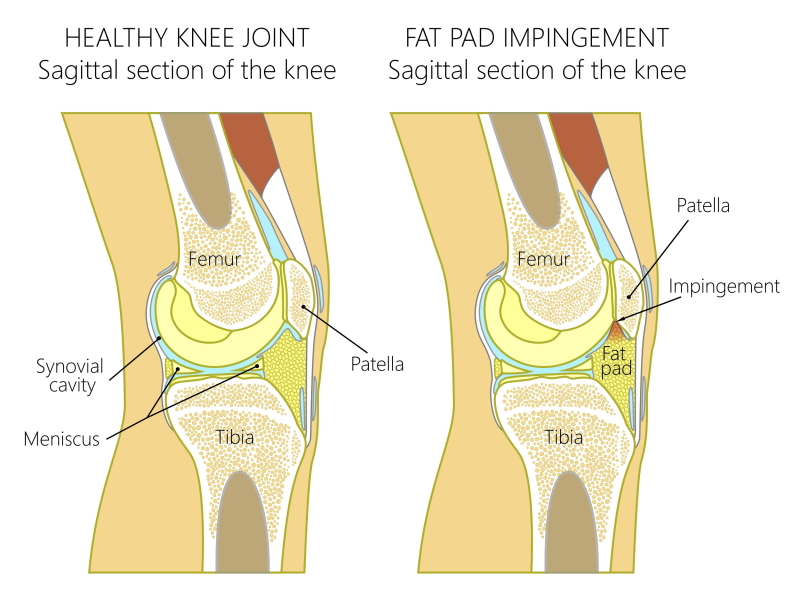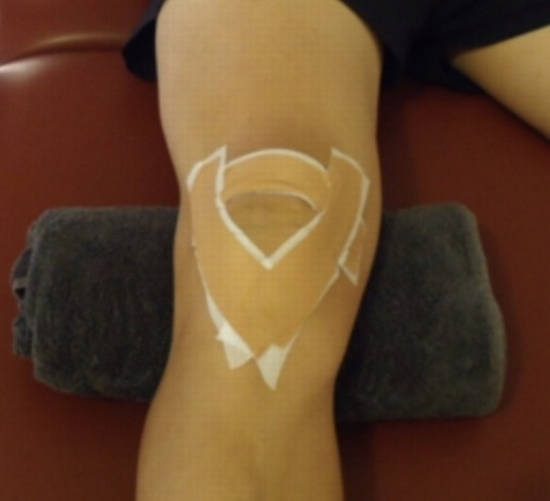Fat pad impingement of the knee, also called Hoffa’s syndrome, is a common cause of pain in the front of the knee. However, we should differentiate this condition from other causes like patellar tendonitis or patellofemoral arthritis. So, how do we correctly diagnose fat pad impingement, and what can we do about it?
What is the fat pad of the knee?
The fat pads are found at the front of the knee, just behind the patellar tendon and kneecap. Many doctors call them Hoffa’s fat pads. We think the fat pads act as shock absorbers during knee movement. Interestingly, the fat pads are the most sensitive structures in the knee, containing many sensitive nerves.
Cause of fat pad impingement

Generally, we think too much activity or sport can cause pinching of the Hoffa’s fat pads between the knee cap and the femoral condyles. This pinching causes low-grade damage to Hoffa’s fat pads, leading to inflammation and scar tissue.
Usually, fat pad inflammation occurs with other knee conditions such as arthritis, patellar tendonitis, and meniscal tears. However, there are other reasons for pinching of the fat pads, including playing sports or a direct fall onto the knee.
Hoffa’s syndrome symptoms
Typical complaints of fat pad syndrome include pain directly on the fat pads on either side of the kneecap and focal swelling. It is essential to rule out other causes of pain at the front of the knee, such as patellar tendonitis or patellofemoral arthritis.
In some cases, imaging is needed to confirm the diagnosis. Often, we use ultrasound or MRI to look at the front of the knee. Usually, in Hoffa’s syndrome, we see swelling in the fat pads on MRI or high blood flow on ultrasound.
How do we treat Hoffa’s syndrome?

Usually, we start with simple treatments. These treatments include exercise therapy to reduce the forces on the fat pads, leg stretching to relieve tightness, and taping or bracing the knee. Other effective treatments include shoe modification or orthotics and soft tissue massage.
Fat pad impingement taping
Often, people find fat pad taping useful to reduce pain from fat pad impingement. Generally, we use three pieces of tape – one on the top, one on the inside, and one on the outside. The taping forms a V shape that reduces pressure on the fat pad.

Is fat pad injection an option?
Yes, but only in a few cases that fail simple treatments.
Usually, your doctor will direct a small dose of cortisone into the fat pad to reduce swelling. Fat pad injections are best done with the help of ultrasound to improve accuracy and minimise side effects. Reducing pain will help in the positive effects of exercise therapy. However, you must be careful as cortisone injection has significant side effects. These side effects include fat pad atrophy and skin depigmentation. Therefore, you should ask your doctor about the side effects of a fat pad injection.
In cases resistant to cortisone, we consider PRP injections for fat pad impingement.
fat pad debridement surgery rate
Surgery like fat pad removal should be avoided and only used as an absolute last resort. Keyhole or arthroscopic fat pad debridement surgery is unpredictable, and some cases worsen after Hoffa’s fat pad surgery. You should only contemplate surgery once you’ve exhausted all other options, including rehab, taping, braces and 1-2 cortisone injections. Also, you need to be sure that the fat pad is the cause of your knee pain – otherwise, surgery could lead to worsening pain.
Final word from Sportdoctorlondon about fat pad impingement
Fat pad impingement is a common cause of pain in the front of the knee. We always recommend simple treatments first. In complex fat pad impingement cases, we suggest you speak to your doctor about a cortisone injection to help with rehab. Fat pad debridement surgery should only be used as a last resort.



Does it go every go away through only therapy?
Hi Miguel – yes fat pad impingement can settle just with therapy.
LM
V shaped taping with tape above the knee relieved pain – what brace is the best would you recommend for this? Or is taping better?
i’d continue to use taping if it helps. Braces can be a little cumbersome.
Hi. I’ve recently done an MRI on my knee and it turns out I have Hoffa syndrome. My doctor suggested I do three injections: one PRP, one hyaluronic acid, and another PRP. However, I think I’d like to try some other alternatives before. I don’t have any other problems on my knee and the pain goes away as long as I don’t weightlift + play sports. What do you think?
Hi Christina,
i’d try non-injection option for fat pad impingement before trying injections. A good physiotherapist or physical therapist should be able to help you with conservative options (eg taping, strengthening).
Regarding injections, PRP is an option although unproven. I’d be wary of hyaluronic acid injections into the fat pad.
Lorenzo
All the best.